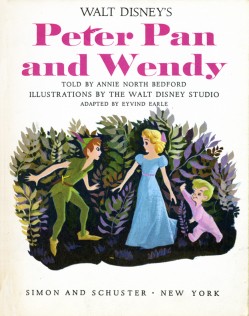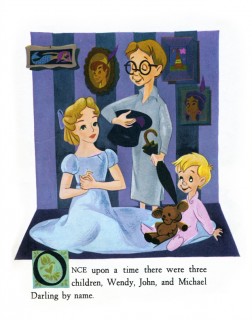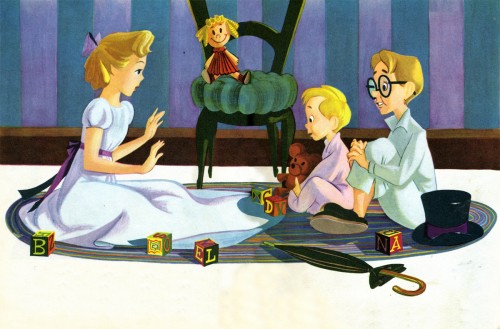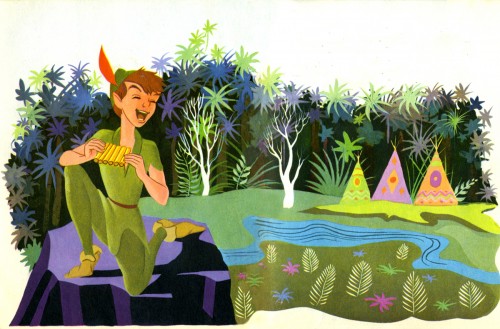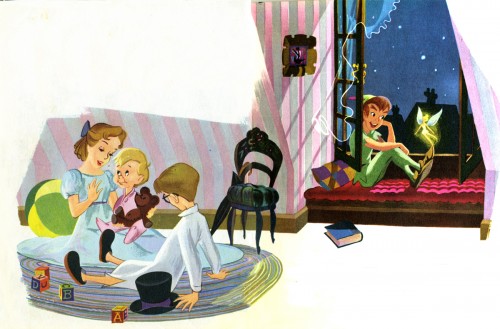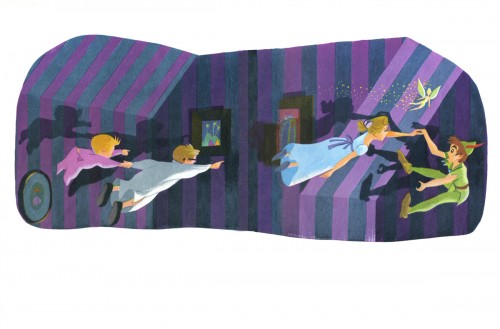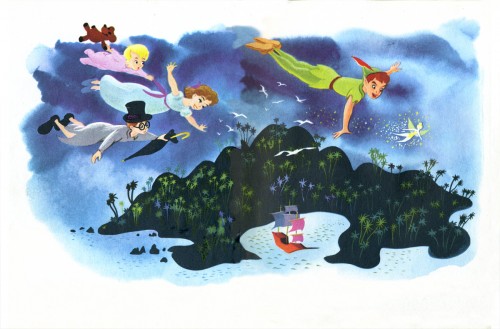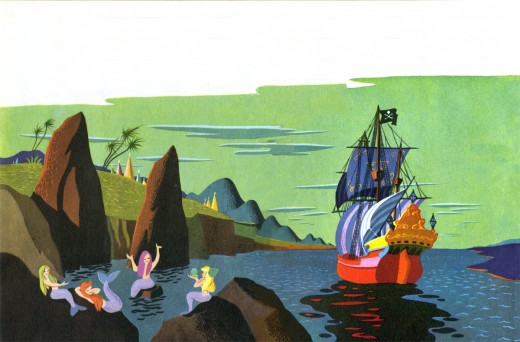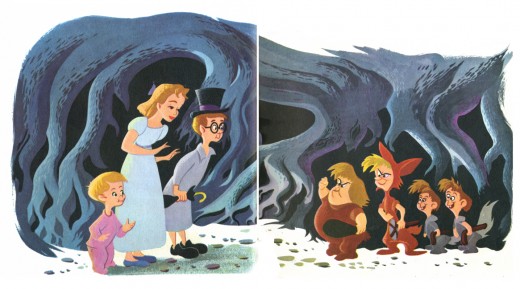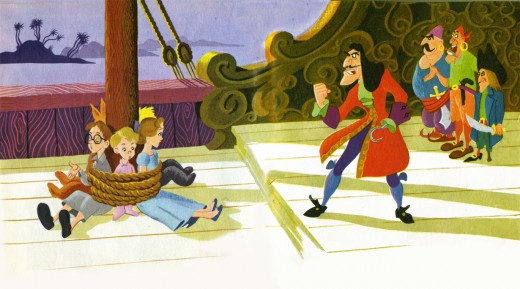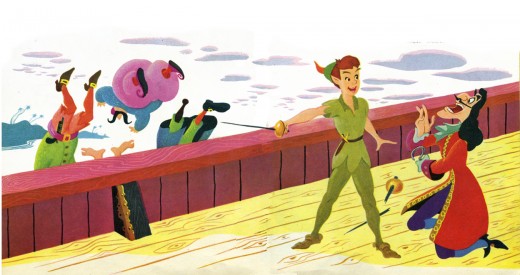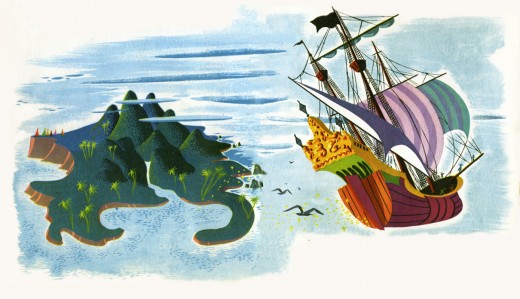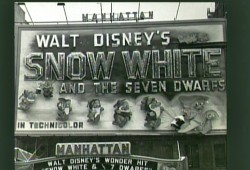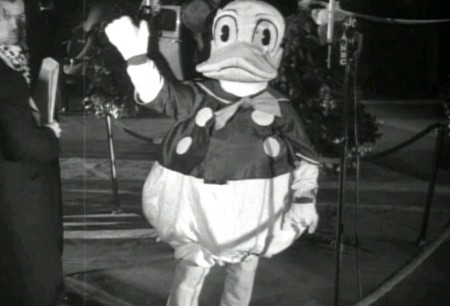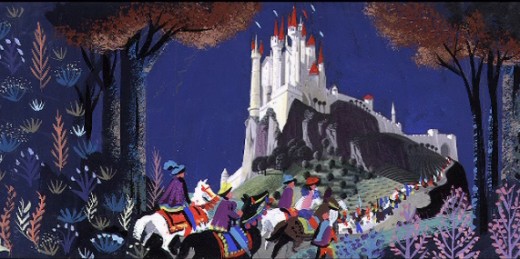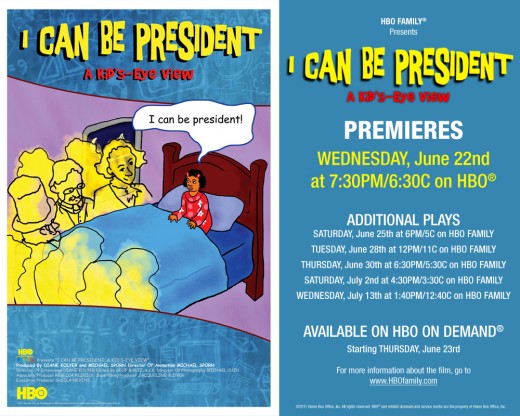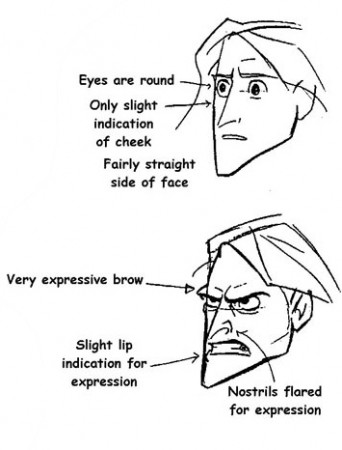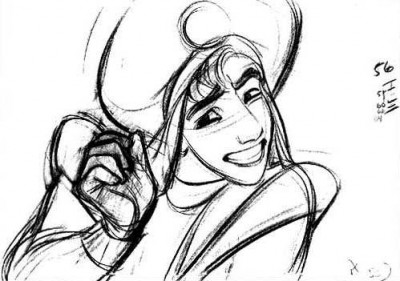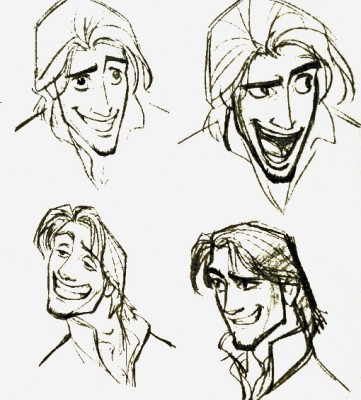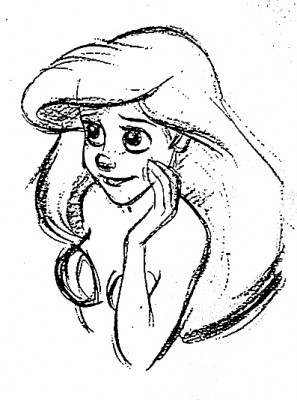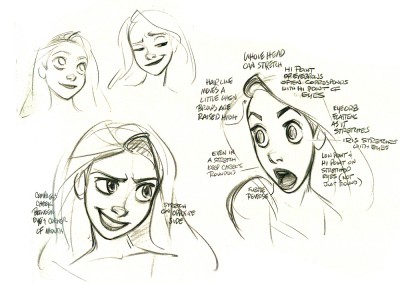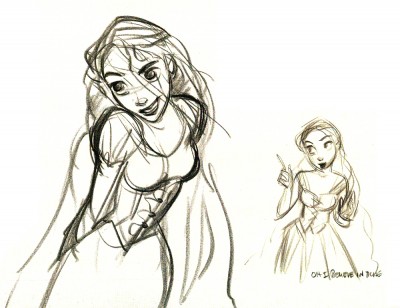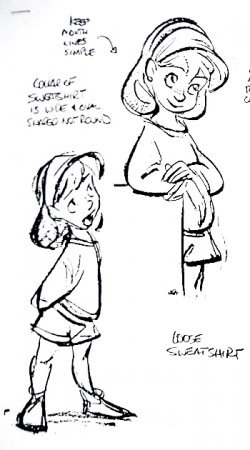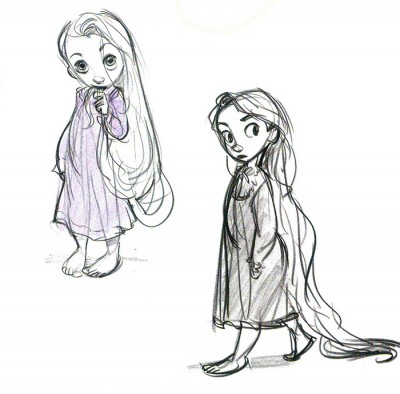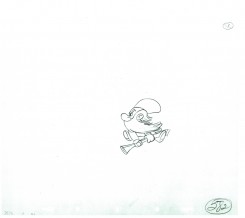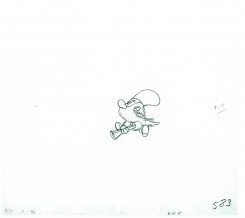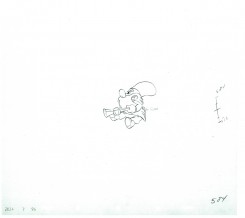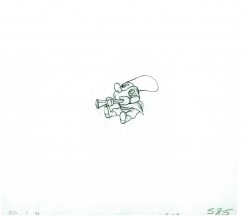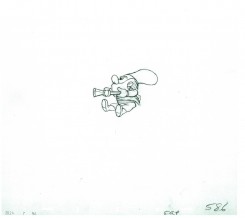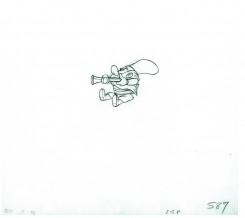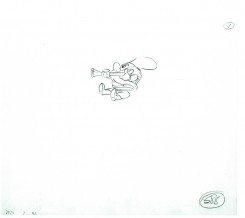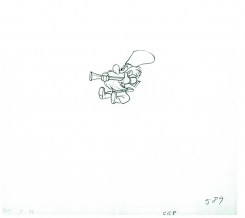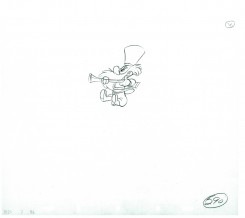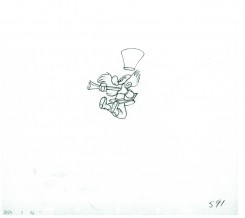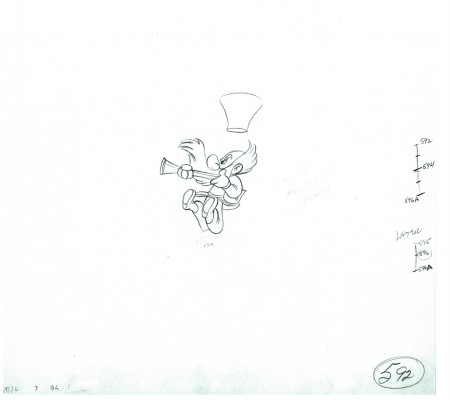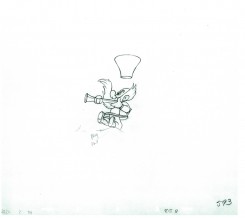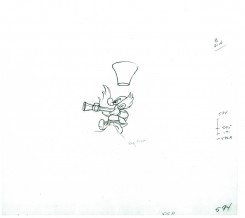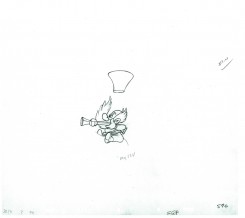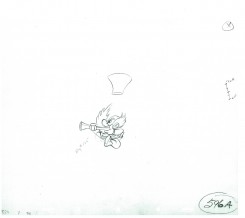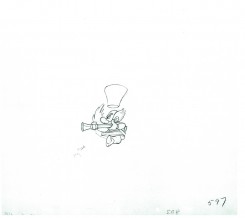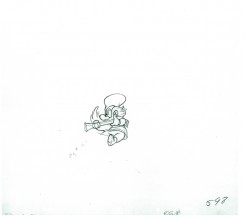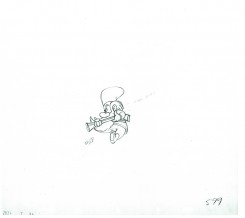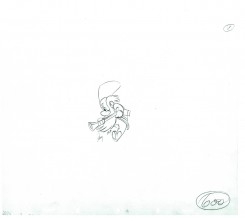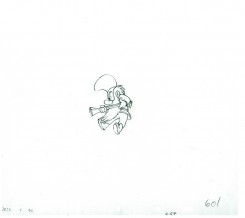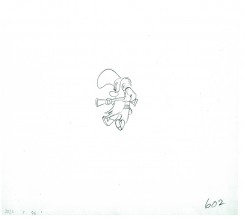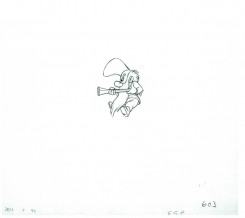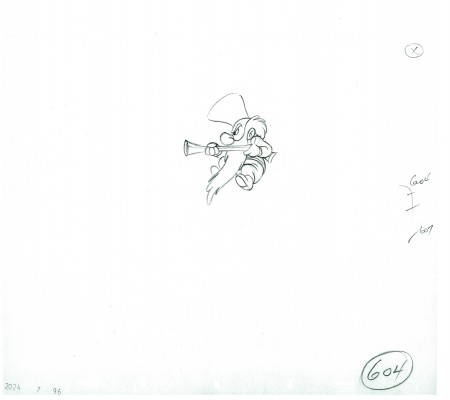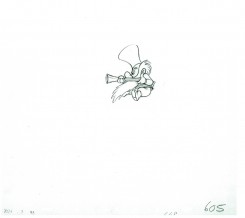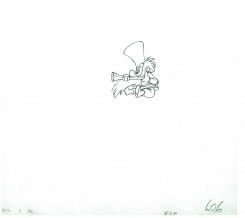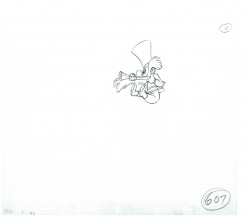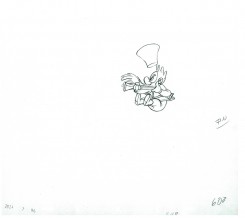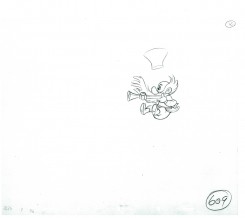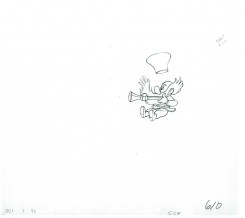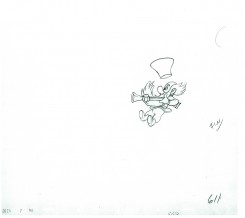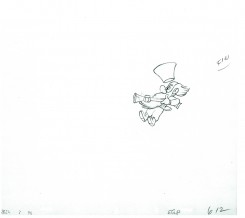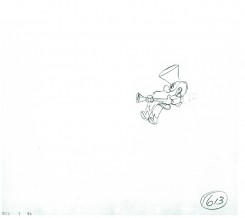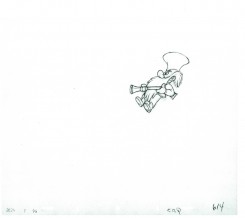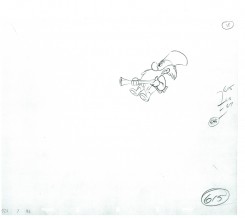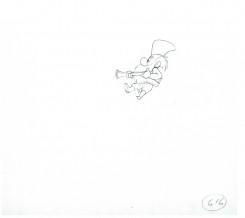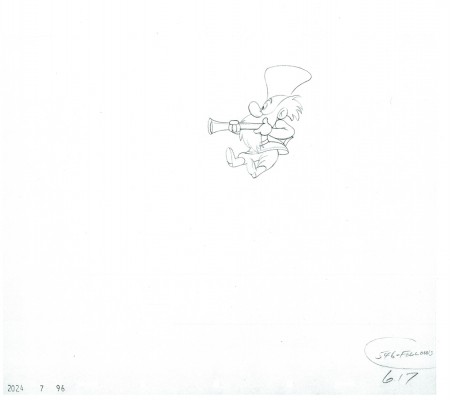Search ResultsFor "sleeping beauty"
Commentary 31 Jan 2012 07:57 am
False “Sincerity”
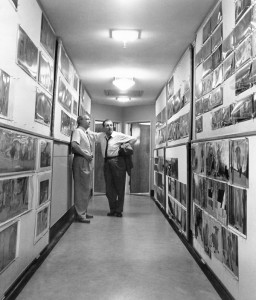 Mike Barrier, on his website, uses a photograph of Walt Disney talking in a corridor to Eric Larson to discuss the state of current day Disney. In the photo, both Walt and Eric are obviously tired at the end of a long and arduous day. Larson remembered, to Mike Barrier, that they were discussing the recently completed feature, Sleeping Beauty, and Walt surmised that at the current expense, he wouldn’t be able to continue to make animated features. That film had cost a bit more than four million dollars in 1958, a whopping sum. (Compare that to the $260 million Tangled cost in 2010.)
Mike Barrier, on his website, uses a photograph of Walt Disney talking in a corridor to Eric Larson to discuss the state of current day Disney. In the photo, both Walt and Eric are obviously tired at the end of a long and arduous day. Larson remembered, to Mike Barrier, that they were discussing the recently completed feature, Sleeping Beauty, and Walt surmised that at the current expense, he wouldn’t be able to continue to make animated features. That film had cost a bit more than four million dollars in 1958, a whopping sum. (Compare that to the $260 million Tangled cost in 2010.)
Mike Barrier‘s point in this article is that features, from that point on, took a slow dip in quality and never recovered. Mike says that he found a falseness setting in to the “sincerity” that Disney requested of his animators, with The Sword In the Stone and Jungle Book being virtually swallowed up by this false “sincerity”:
- “I think the falseness I saw was rooted, paradoxically, in that Disney shibboleth ‘sincerity.’ As Walt used the term, during work on the first great features, it was the characters who were to be sincere, that is, to seem to move of their own volition. Over the years, sincerity came to be valued less in the characters than in their animators (and, at one step removed, their directors), until now we are supposed to admire animation because its practitioners—assuming a high level of technical skill—are conspicuously earnest, in a way that many of the great early Disney animators were not.”
I have to agree, for the most part, with this theory. I think it most obvious in the Jungle Book. With The Aristocats, to me, they’d sunk completely and hopelessly off the map. I’ve sat through this film at least half a dozen times and have not been able to stay awake throughout it. The film is not one of my favorites.
Mike Barrier takes The Sword In the Stone as the first full on example of this problem, whereas I love that film, though I admit that it has significant problems. I agree with him on the next one, The Jungle Book, but Andreas Deja would disagree heartily – it was this film that convinced him to become an animator.
I remember discussing Beauty and the Beast with John Canemaker and my saying that I had trouble enjoying it, finding an ugliness in most of the characters – those townspeople cannot be drawn more poorly. But then John asked me if I didn’t think that this would be a film that would encourage lots of young people to want to become animators just as we had been inspired by some of the films of the fifties. It was obvious that I had to agree immediately.
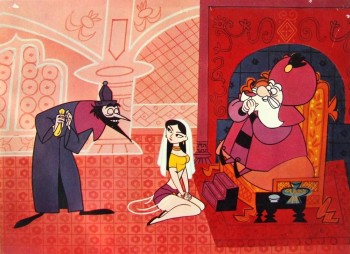 I recognize that The Sword In the Stone was right at the time that I was in love with most of the fare coming out of Disney’s studio, as a matter of fact out of most studios. 1001 Arabian Nights with Mr. Magoo was certainly an influence on me.
I recognize that The Sword In the Stone was right at the time that I was in love with most of the fare coming out of Disney’s studio, as a matter of fact out of most studios. 1001 Arabian Nights with Mr. Magoo was certainly an influence on me.
One of those commenting on Barrier’s column, Garry Apgar, points to Ichabod and Mr. Toad as one of the best of the Disney films, “I was enthralled by the magic of both, and to this day consider the Toad half of that combo picture, “pound for pound” . . . the greatest Disney cartoon ever. I still have the Giant Golden Book edition of that story.”
Personally, except for the ride of the Headless Horseman, I find very little inspiring in that feature. I’d guess that Mr. Apgar was influenced because he saw the film at a time when he was strongly influenced by it, just as I saw The Sword In the Stone at a susceptible time in my life. However, despite that, I have difficulty finding much bad in the film. Yes, I hear odd echos in some of the voice track; the music is completely anachronistic, and some of the animation is not up to the work of the past. I’ll even say that I have a major problem with the wizards’ duel in that the mad Madame Mim is introduced late in the film just for the sake of the set piece, the duel. She’s then dismissed. I have always found that a wart in the storytelling. Somehow the late introduction of the squirrel females doesn’t bother me. Perhaps because they’re squirrels.
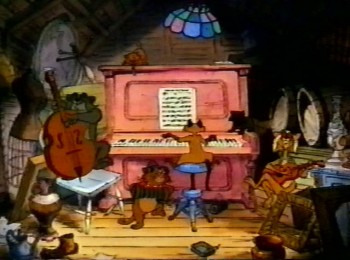 Basically, I’m saying that we’re all affected by our influences – not necessarily the quality of the actual film. Those who have seen The Aristocats at a vulnerable time in their lives, probably like that movie, and I can’t really fault them though I know it’s not a benchmark in Disney animation, and, in fact, is definitive proof of Barrier’s theory about the false “sincerity” in the animators’ work and, more to the point, the director’s work. (I can remember Ken Anderson, Frank Thomas and Ollie Johnston talking about the disco-lights used in the jazz-in-the-attic section of the film. Woolie Reitherman could not be coaxed out of the 70s effect despite the fact that it was already dated when the film was released.)
Basically, I’m saying that we’re all affected by our influences – not necessarily the quality of the actual film. Those who have seen The Aristocats at a vulnerable time in their lives, probably like that movie, and I can’t really fault them though I know it’s not a benchmark in Disney animation, and, in fact, is definitive proof of Barrier’s theory about the false “sincerity” in the animators’ work and, more to the point, the director’s work. (I can remember Ken Anderson, Frank Thomas and Ollie Johnston talking about the disco-lights used in the jazz-in-the-attic section of the film. Woolie Reitherman could not be coaxed out of the 70s effect despite the fact that it was already dated when the film was released.)
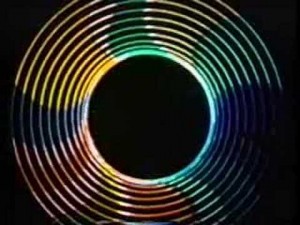 But back to the comments section of Mike Barrier’s site. Jim Korkis was surprised while teaching Animation History to a number of young interns at the Disney studio. “They had no acquaintance with any silent animated cartoons that were the foundation nor any of Walt’s competitors in the Thirties and Forties like Paul Terry, Warner Brothers, MGM and others. Even as the class approached the beginning of computer animation, they had no clue how and why computer animation developed.”
But back to the comments section of Mike Barrier’s site. Jim Korkis was surprised while teaching Animation History to a number of young interns at the Disney studio. “They had no acquaintance with any silent animated cartoons that were the foundation nor any of Walt’s competitors in the Thirties and Forties like Paul Terry, Warner Brothers, MGM and others. Even as the class approached the beginning of computer animation, they had no clue how and why computer animation developed.”
This has become the state of the world. It’s not only animation. Just focusing on the Arts, I see it everywhere.
- There’s no knowledge of Vaudeville among the young performers and creators trying to sell their wares to theatrical shows. When Stephen Sondheim, Charles Strouse and John Kander die so will the history of the theater.
- I wonder how many architecture students have read Ayn Rand’s “The Fountainhead.” Certainly not for the confused libertarian views, but for the threat of two different architectural forces that dominated the world in the early Twentieth Century.
- How many Fine Artists explore early Renaissance Art, except within their Art History classes? Do they question why and how Daumier painted as he did? What about Turner, do they understand what he was trying to do? Or David? This is our history; it’s the foundation of the future. Only by going through his apprenticeship to Thomas Hart Benton could Pollock paint his splatter paintings.
Animation students should do more than study scenes that have already been animated. By limiting yourself to how Milt Kahl or Tex Avery did something, you’ve eliminated the world. This is what you’re caricaturing in your animation, I should think. Regurgitated Jim Tyer is not only not art but it’s not Jim Tyer. And it’s not good. Art Babbitt, while at the Disney studio, took piano lessons and dance lessons knowing that it would help his animation, and undoubtedly it did. It’s more important to take those dance lessons (and more fun, too) than it is to study all of Tytla’s scenes.
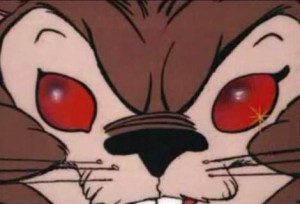 I’m not saying that animators shouldn’t study past animation, but what I am saying is that it’s the world outside your body that is shaping any artistry within you. Imitating Chuck Jones’ blinks won’t help you other than knowing that Jones did it that way.
I’m not saying that animators shouldn’t study past animation, but what I am saying is that it’s the world outside your body that is shaping any artistry within you. Imitating Chuck Jones’ blinks won’t help you other than knowing that Jones did it that way.
Learn about your business, but also learn about the world. That’s the only way you can relate to how your character should think and emote. All of the Disney drawings on this site and other ones really won’t help you figure out YOUR character’s development. Only you can do that.
Books &Disney &Illustration &repeated posts 12 Jan 2012 06:45 am
Eyvind Earle – Peter and Wendy
Back in 2007, I posted this piece on Eyvind Earle’s Peter Pan illustrations. I’ve combined the two parts and repost it here.
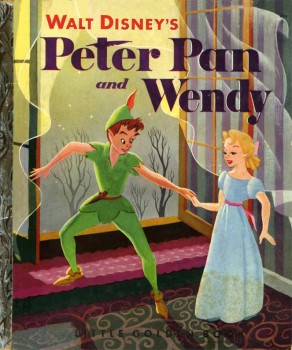 – I’m an Eyvind Earle fan. I have been ever since getting my hands on Bob Thomas‘ original version of The Art of Animation (1959), which promoted Sleeping Beauty and its artwork, and then going up to Radio City Music Hall to see the first theatrical run of the film.
– I’m an Eyvind Earle fan. I have been ever since getting my hands on Bob Thomas‘ original version of The Art of Animation (1959), which promoted Sleeping Beauty and its artwork, and then going up to Radio City Music Hall to see the first theatrical run of the film.
After the Disney film, I saw Earle’s Nativity film on the Tennessee Ernie Ford show and Paul Bunyan and other Disney shorts of the period made me more of a fan.
I got to meet the man thanks to Michael Barrier. We had one of the craziest interviews ever when we drove upstate to his house and sat in a somewhat darkening room as the afternoon dimmed and Earle continued to quietly answer the questions.
I loved that day, but I loved Earle’s work even more. After posting Retta Scott‘s Golden Book of Cinderella, I realized that I had this book, Peter and Wendy, which is Earle’s odd adaptation of Peter Pan. He’s obviously in love with Cinemascope in that most of the book’s illustrations are two-page spreads. Sort of wide screen proportions. This is unusual for a Little Golden Book.
The images look a bit like the backgrounds in Paul Bunyan, and the characters are not quite on model with the film. The printing, as with most of these books, is pretty dull. You know a lot has been lost in the transfer.

This last illustration is my favorite.
Daily post &Frame Grabs &repeated posts 26 Dec 2011 06:37 am
Making Snow White
- On the Snow White dvd, there’s a documentary about the history and making of the film. Some of the images on the disc are just too precious for me to allow them to slip by without my singling them out and writing about them.
.
Here are frame grabs from this documentary.
.
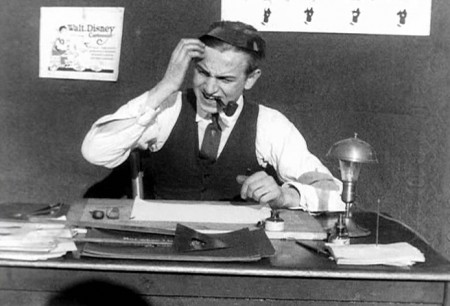
Walt is presented as a bumpkin in the early days.
I suppose he was directing if not filming this material,
so that’s the image he sought to create as well.
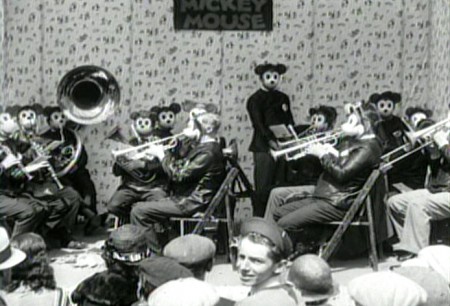
This has got to be one of the wackiest pictures in their archives.
The popularity of Mickey Mouse in the early 30′s.
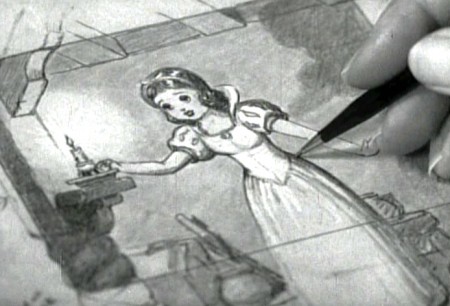
Snow White brings a change to the studio,
which you can well understand.
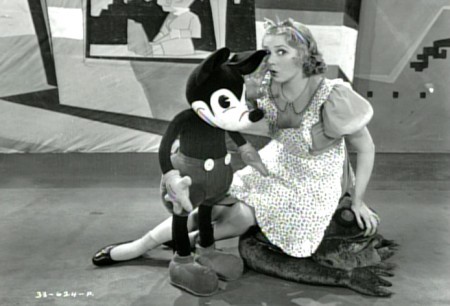
Though there’s still the problem about what to do with Mickey.
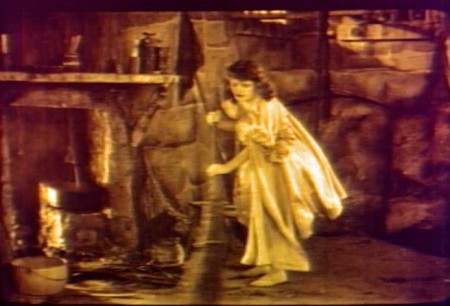
Disney was supposedly inspired by a silent filmed version
of Snow White he saw in his younger days.
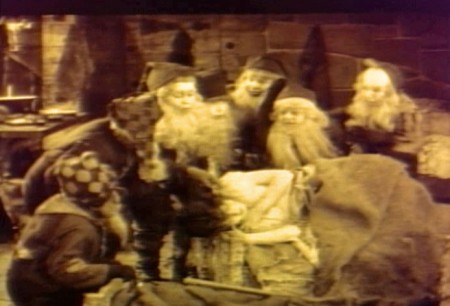
One wonders if there was also an eerie creepiness to the performance
that Walt gave to all of his animators one night as he acted out the film.
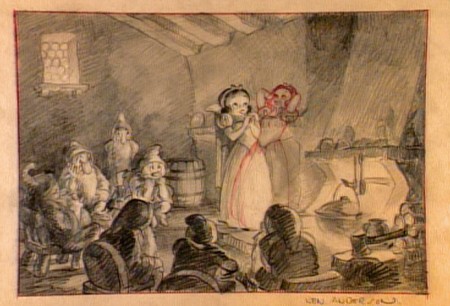
I’m curious about the pose of Snow White with her head back
and her hands behind the head.
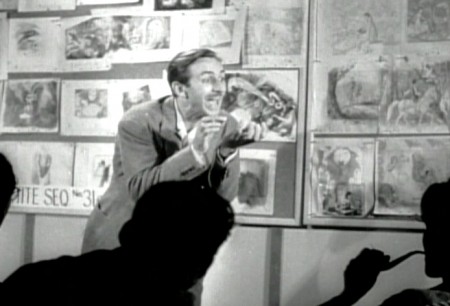
Here, Walt tries to get his animators to bite into an invisible apple -
the future of animation – as they thoughtfully smoke their pipes.
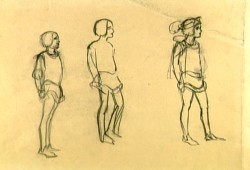
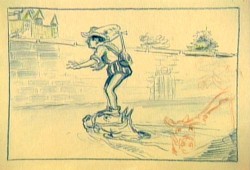
The bed building and the soup eating scenes weren’t the only ones that were
excised from the finished film. It seems the prince, initially had a larger role.
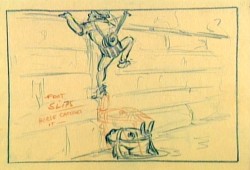
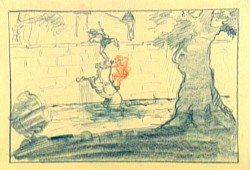
The path into the castle was a bit more difficult. First you had to
get past the moat with the help of your horse. Here the prince looks
a bit like Robert Benchley.
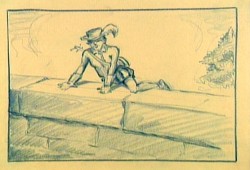
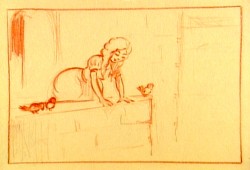
“Romeo, Romeo, Wherefore art thou, Romeo?”
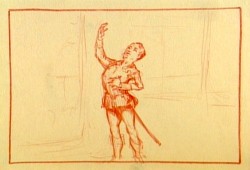
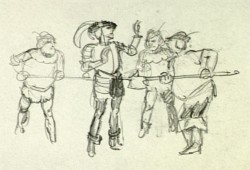
Getting caught. Obviously, the Queen and Snow White didn’t live in that
castle by themselves. There were henchmen we didn’t know about.
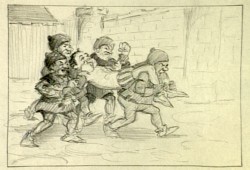
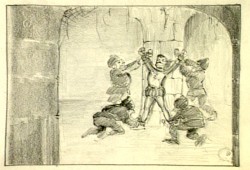
This almost looks like an early version of the seven dwarfs
carried the prince to prison.
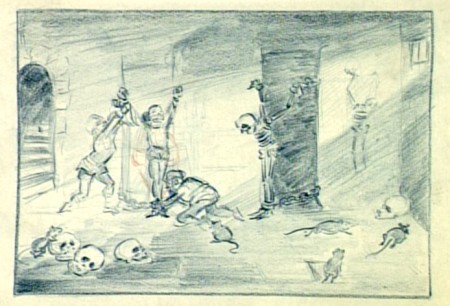
They had big rats in that prison. Scary.
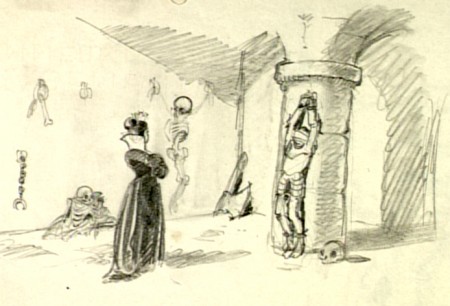
This is an obvious precursor of Malificent going to visit Prince Phillip some
20 years later in Sleeping Beauty. Both wicked Queens got more attractive.
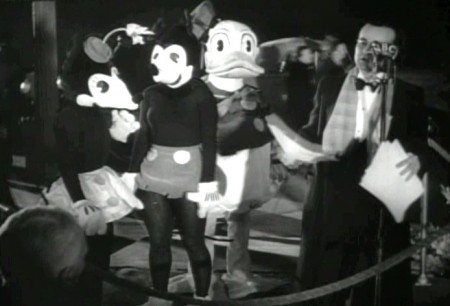
Lots of stars showed up to the grand premiere.
These actors in costume were there, too.
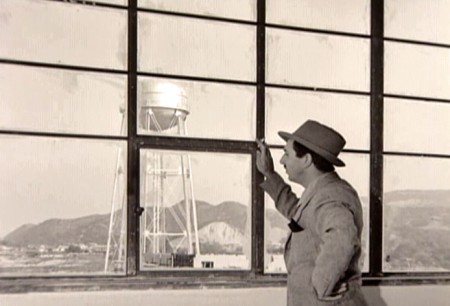
In all seriousness, the film was a masterpiece. I’m still studying it some
74 years later. Walt had reason to be proud and happy. He also had enough
money to move onto other challenging films, and he took the challenge as
opposed to making Snow White 2 or 3 (as they probably would do today.)
Commentary &Disney 18 Jun 2011 07:34 am
Sight Seeing
- This past week Jonna commented on this blog: I can only imagine how it would have been to see one of the classics at a theater (I was born in the 90’s). It would have been great fun if any of you told about a premiere or screening that you’ve attended (e.g. the first time you saw Sleeping Beauty or something).
So I thought of a couple of memories I have of seeing some of the classic Disney films theatrically for the first time. So kiddies gather round Gran’pa while he tells you a story.
 The first film I’d ever seen was Bambi. I don’t remember much about it, but I’m sure that the experience permeated my brain and sent me on a direction I could never return from. This is still one of my favorite classic Disney films. I’m not big on the cutesy aspects of the movie – specifically the “twitterpated” sequence, but I am big on everything else. Back in those days, there were often Surprise guests coming to the movie theaters to promote the shows. At this one particular event, to celebrate Christmas they drew back the curtain and had a pile of large gifts all wrapped in foil-colored gift wrap. Clarabelle the clown from the Howdy Doody Show was a special guest who was going to give out gifts to the boys and girls in the audience. He went through a short routine which ended with the supposed gift-hand-out. But it didn’t happen that way. Clarabelle took out his bottle of seltzer and started spraying the audience. The blustered theater manager called for the curtain to be closed, and that was that. Even at the age of 4 or 5, I knew we was robbed. No wonder I couldn’t remember much about Bambi.
The first film I’d ever seen was Bambi. I don’t remember much about it, but I’m sure that the experience permeated my brain and sent me on a direction I could never return from. This is still one of my favorite classic Disney films. I’m not big on the cutesy aspects of the movie – specifically the “twitterpated” sequence, but I am big on everything else. Back in those days, there were often Surprise guests coming to the movie theaters to promote the shows. At this one particular event, to celebrate Christmas they drew back the curtain and had a pile of large gifts all wrapped in foil-colored gift wrap. Clarabelle the clown from the Howdy Doody Show was a special guest who was going to give out gifts to the boys and girls in the audience. He went through a short routine which ended with the supposed gift-hand-out. But it didn’t happen that way. Clarabelle took out his bottle of seltzer and started spraying the audience. The blustered theater manager called for the curtain to be closed, and that was that. Even at the age of 4 or 5, I knew we was robbed. No wonder I couldn’t remember much about Bambi.
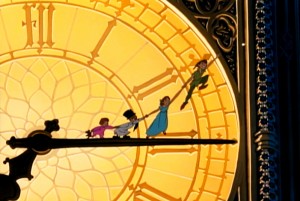 The second film I’d ever seen was Peter Pan. That would have been for the 1953 theatrical release. My father took me to one of those large movie palaces in upper Manhattan, the Loew’s 181st Street. I remember it playing with a film about a jungle cat of some kind; I’ve always remembered this as The Black Cat, but that title isn’t right. So I obviously don’t remember the title of the film, a B&W scary movie.
The second film I’d ever seen was Peter Pan. That would have been for the 1953 theatrical release. My father took me to one of those large movie palaces in upper Manhattan, the Loew’s 181st Street. I remember it playing with a film about a jungle cat of some kind; I’ve always remembered this as The Black Cat, but that title isn’t right. So I obviously don’t remember the title of the film, a B&W scary movie.
Re the animated feature, I remember most the swirls of color of Pan and gang flying; I don’t remember much else about it from that initial introduction. I was absolutely enamored with the moviegoing experience from The Black Cat to the brilliant cartoon. Remember, I was only 6 or 7 years old, at the time.
In 1955, I was in charge of about five kids (a couple of siblings and a couple of cousins) going to a local theater to see the NY premiere of Lady and the Tramp. Back then, it would cost 25 cents for a kid to get into the movies. When we’d gotten to the local movie theater for this film, they’d raised the price to 35 cents – more than our parents had allotted.
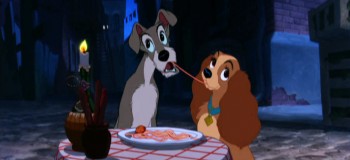 Outside the theater we were counting up our monies and trying to figure out how much we’d need to get in and buy some candy or popcorn for all of us. Within seconds my cousin announced that she’d lost her money, and it was obvious there wasn’t going to be enough for refreshments. The cousin started crying loudly, bawling until the movie theater manager came up to ask what was the problem. She spluttered out the word that she couldn’t afford any candy now that she’d lost the money to get into the movie. The manager just reached into his pocket and gave me an additional dollar. Enough money for movie and candy and more importantly it stopped my cousin’s screaming.
Outside the theater we were counting up our monies and trying to figure out how much we’d need to get in and buy some candy or popcorn for all of us. Within seconds my cousin announced that she’d lost her money, and it was obvious there wasn’t going to be enough for refreshments. The cousin started crying loudly, bawling until the movie theater manager came up to ask what was the problem. She spluttered out the word that she couldn’t afford any candy now that she’d lost the money to get into the movie. The manager just reached into his pocket and gave me an additional dollar. Enough money for movie and candy and more importantly it stopped my cousin’s screaming.
Once inside the theater I ignored them – even though the cousins were badly behaved and squirmed about through most of the show. I liked the film so much that I made the whole group sit with me to watch it a second time. That big, wide Cinemascope screen. It was heaven.
We did this often back then. I remember another time going to see Pinocchio with my younger sister, Christine. We sat through Pinocchio three times before we left the movie theater. That meant we had to sit through the second feature (usually some live action dud) twice to get to the third showing of the cartoon. My sister reminds me often enough that when she turned around she’d seen that the theater was empty except for the two of us. The usher stood in the back giving us the evil eye.
Prior to Sleeping Beauty‘s release, I’d been doing some reading. I’d received Bob Thomas’ The Art of Animation the previous Christmas, and I read it over and over at least a hundred times. I memorized every still in that book and couldn’t wait to get my eyes on Sleeping Beauty.
The film opened at Radio City Music Hall, and I was given permission to make one of my first trips downtown to see the film. An hour subway ride for a 12 year old. I went into this largest of movie theaters in the City, and I picked a great seat. The audience wasn’t overflowing; the show wasn’t sold out. But it was BIG.
The screen is enormous in that theater, and Sleeping Beauty was made to fill such a screen, especially in its Technirama debut. But somehow I came out of the theater disappointed. I don’t know what had gotten into me. I don’t remember any reason for disliking it. As a matter of fact, I absolutely love the film now. Those Eyvind Earle settings; the great animation of Maleficent; the dragon fight. There’s just a million reasons I have for loving it, but something about that first viewing left me cold. And I remember trying to analyze, at the time, what I thought was missing from the experience. I had no answer.
I’ve seen all of the pre-cgi Disney films in theaters. I also remember all the experiences of sitting through them. Dumbo and Alice In Wonderland were the only two that I saw on TV first. They were both special presentations on the Disneyland show. Eventually, I’d see them both in theaters at special screenings.
Of all of them, Dumbo still stands as my favorite though in a close tie to Snow White. There’s something they both have that goes beyond the brilliant animation and the graphics on screen. There’s an emotion there that they both have, not quite an innocence but more like a daring. Without consciously saying it, you felt the Disney people were shouting, “Look what we can do!” And they did do it. (By the time they did Fantasia, they were too conscious of what they could and had done, and they’d lost it – for me.)
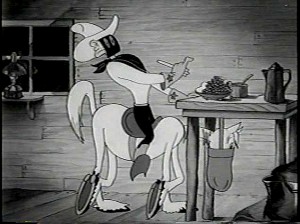 Eddie Fitzgerald is either a genius or a real-life looney toon – who I treasure. Probably, I think both; he’s at least an original. His blog is like no other in that he gives us real deep rooted comedy that makes you laugh aloud. He puts together these photo-montage storyboards creating a wacky movie that you just gotta keep reading, and when he’s on the mark, there’s nothing short of brilliance.
Eddie Fitzgerald is either a genius or a real-life looney toon – who I treasure. Probably, I think both; he’s at least an original. His blog is like no other in that he gives us real deep rooted comedy that makes you laugh aloud. He puts together these photo-montage storyboards creating a wacky movie that you just gotta keep reading, and when he’s on the mark, there’s nothing short of brilliance.
Bob Clampett did a wacky WB short called The Lone Stranger and Porky. Obviously, it was a parody of the big radio show of the time, The Lone Ranger. Well, Eddie takes off on that parody and does Clampett one better. It’s crazy and hilarious and you have to check it out (if you haven’t already.) The Lone Stranger (Parody) via photomontage.
Someone should finance this guy to make a real movie. This artwork would take cgi in a direction that hasn’t been considered before. Maybe then they’d have the first REAL animated cgi film instead of all these cutesy viewmaster things we get.
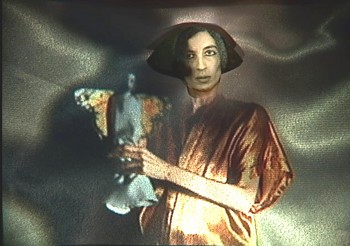 Last week I started a new series that I hope will go on forever. I’ve been interviewing Independent animators, the ones who are trying to make artful animation on their own. They don’t have the dollars that a Dreamworks would, but they’re using all of their resources to make movies that have something to say.
Last week I started a new series that I hope will go on forever. I’ve been interviewing Independent animators, the ones who are trying to make artful animation on their own. They don’t have the dollars that a Dreamworks would, but they’re using all of their resources to make movies that have something to say.
The first post was an interview with George Griffin, who has been something of an inspiration to me. Upcoming this Tuesday will be an in depth look at the amazing career of Kathy Rose. She takes animation, mixes it with dance and Performance Art and comes out with amazingly original work. I’m having a good time putting these pieces together, and there are so many who deserve the attention.
- I have one last bit of self-aggrandizement to post. THis coming Wednesday, June 22nd, HBO will premiere the latest Special we’ve done for them. (Notice how I date myself by calling it a “Special”. That’s what they were called when I was younger. These days I only know the industry word for them, “one offs”. I don’t like to think of my show as a “one off”; it’s a Special.)
The show is about half animated; the other half consists of kids saying the wackiest things. It’s fun. So there you go.
Books &Commentary &Disney 04 Jun 2011 06:52 am
Don Hahn’s Brainstorm & Other Brickabrack
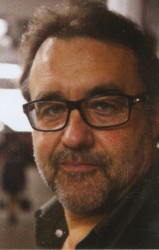 - Don Hahn is a busy guy. Aside from producing Beauty and the Beast, The Lion King and The Hunchback of Notre Dame, he’s produced the Disney nature documentaries Earth, Oceans and African Cats. He’s also directed Waking Sleeping Beauty about the renaissance of Disney animation.
- Don Hahn is a busy guy. Aside from producing Beauty and the Beast, The Lion King and The Hunchback of Notre Dame, he’s produced the Disney nature documentaries Earth, Oceans and African Cats. He’s also directed Waking Sleeping Beauty about the renaissance of Disney animation.
Mr. Hahn has also written a number of books, starting with Animation Magic through Disney’s Animation Kit as well as The Alchemy of Animation up to his most recent (non-picture) book, Brainstorm: Unleashing Your Creative Self.
I recently picked up Brainstorm and have read it, so I thought I’d write a few comments. I believe this is an updated and expanded version of the earlier book, Dancing Corn Dogs in the Night. In either incarnation, it’s an easy-to-read book with a light and casual sense of humor. Mr. Hahn is very comfortable in the skin of the light raconteur; he often tells stories that are witty and help to direct his point. This is a book about the creative process, and it tries to tell people how to get their artistic side out of their bodies.
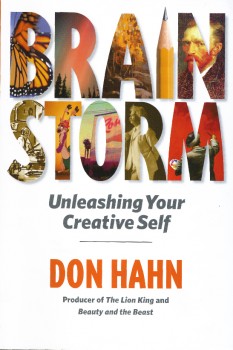 This process is best told in a story wherein a younger production manager calls Hahn in the evening asking to come up to his office. When they meet, the young executive says he needs advice: he’s trying to write a screenplay and is stuck. He wants Hahn’s advice as to how to get going. Hahn tells us that “the most successful writers write because they have to.” The conversation, he tells us, really came down to how much the writer “really felt he had to write.” Hahn says that he felt the writer had shortchanged himself; he needed the courage to be honest with himself and make big changes in his career path. “He had to be authentic.”
This process is best told in a story wherein a younger production manager calls Hahn in the evening asking to come up to his office. When they meet, the young executive says he needs advice: he’s trying to write a screenplay and is stuck. He wants Hahn’s advice as to how to get going. Hahn tells us that “the most successful writers write because they have to.” The conversation, he tells us, really came down to how much the writer “really felt he had to write.” Hahn says that he felt the writer had shortchanged himself; he needed the courage to be honest with himself and make big changes in his career path. “He had to be authentic.”
There are many such stories like this in the book, and they all feel authentic. It’s just that they all feel as though they’re adding up to be a Self-help book. There are many lines which I had to squirm through with ideas that no one would really have to tell an artist. The hardest line for me in the book is: “Shakespeare must have loved putting words together. He was like a phrase machine. If one guy was able to be that innovative with language in the sixteenth century, then why can’t we be more innovative?” The answer, of course, is that Shakespeare was the greatest living writer-as-artist that there ever was. He was a genius. I am not a genius, but I would never compare myself with Shakespeare. Maybe Stephen Sondheim might be comparable, but don’t ask me to be innovative so that I can be more like Shakespeare! I think of myself as someone trying my entire life to be an artist; I don’t have a problem being innovative, but I also can’t put myself in the same sentence with Shakespeare.
As such, I had a bit of a hard time reading it. I never in my life have had a hard time expressing myself artistically and have never needed advice on how to allow the muse to flow from myself. I don’t have a hard time getting started; more so I have a hard time stopping.
It was difficult for me to contain myself while reading a how-to book on the artistic process. “Art for Beginners” is not something I really needed to read, however the stories told kept me moving on through the book, and I’m sure they’ll entertain you as well. There’s the story of Dick Williams disappearing from his studio while preparing for a deadline in animating a scene, only to return very late in the deadline to whip it out. He had his own process of preparation. Or there’s the story of meeting Woolie Reitherman for the first time and hearing him call John Huston during the meeting (which leads to Hahn’s casual comparison between Reitherman and Huston.)
There are many stories we haven’t heard before, and for that alone, I felt the book was worth reading. I also appreciated that it might help some people to get the creative process going, if they are novices trying to think of themselves in artistic terms. I assume there are many such people out there.
2000
- This is the 2000th post I’ve put up.
No wonder my typing fingers are sore.
____________________
A Bad Start
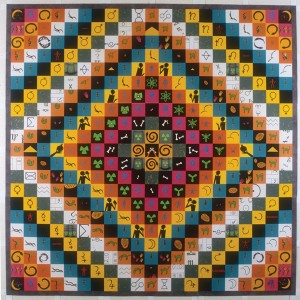 - Things started off roughly this week. First thing in the morning on Tuesday I was greeted with the news that Karen Aqua had died. It took a lot out of me that day. To lose so enormous a talent is difficult; to lose a friend in the animation community is even harder. We lost both with that email.
- Things started off roughly this week. First thing in the morning on Tuesday I was greeted with the news that Karen Aqua had died. It took a lot out of me that day. To lose so enormous a talent is difficult; to lose a friend in the animation community is even harder. We lost both with that email.
I posted my little post – not much more really, than Karen’s husband, Ken Field‘s telling of the news and information about a memorial service (when I know more about that I’ll pass the news on) – , but I found a wealth of Independent animators checking in to express thier feelings. Everyone from Candy Kugel to Kathy Rose, Joanna Priestly to Paul Glabicki. _____________Civilization by Karen Aqua
I realized with that open expression that there really is no place for the Independent animator to check in for news or stories about their work. Non studio artists are left to their own blogs and websites to promote their animation while multi-mega-budget films are given top headlines over whether or not they’ve broken the $100 million mark. It just doesn’t seem fair to me.
So I’ve decided to step tentatively into this water. I’m going to devote a day of the week (probably Tuesday or Thursday) to writing about some filmmaker/artist/animator. It’ll probably be a mix of reviews, interviews and bios of some of our best artists. Shameless promotion for the films that deserve more attention.
Independent animators: don’t hesitate to contact me if you have anything you’d like to promote or news you’d like to share or even if you’re just interested in having your films be a focus for a day.
- Speaking about that post, I was glad to see Cartoon Brew finally comment on Karen’s passing by directing people to my blog, but I was annoyed to see another blog lift my piece verbatim and post it on their site – not even separating my stills from their enlarged versions so that when you clicked a still it sent you to my site. Ordinarily, I wouldn’t mind, but I do like when they give my blog credit. Unfortunately, there was no naming of the origination of this post, and the blogger passed it off as if it were his own.
People, we have to have some modicum of courtesy out there !
I also contacted Ron Diamond at AWN to make sure they’d have a note about Karen on their site, (I knew they would, they’re usually just a tad slow in getting it done) and, indeed, they said one was in the works. It was posted that same day.
- The Holland Animation Film Festival has made a decision to move its date from Autumn to Spring. That means their next Festival will take place in the Spring of 2012, and there will be no Holland Animation Festival in 2011. The next edition is from 28 March through 1 April 2012.
I haven’t attended any of their Festivals, but for some reason I suspect this is one of the better ones out there. Maybe I should aim to go in 2012 if I can ever finish another film.
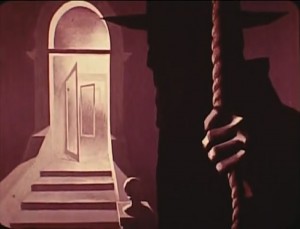 - Hans Bacher has posted a number of beautiful posts on Paul Julian‘s work on The Hangman, a film he directed in 1964. Go here and here to see the two already up and they will lead you to past posts on Julian’s work.
- Hans Bacher has posted a number of beautiful posts on Paul Julian‘s work on The Hangman, a film he directed in 1964. Go here and here to see the two already up and they will lead you to past posts on Julian’s work.
In the past, I’ve posted a couple of Julian’s books, Toot and Piccoli.
I’ve also done posts about Paul Julian‘s work for Roger Corman. You can see those posts here.
You can see a reddish print on YouTube here.
Photos &repeated posts 23 Jan 2011 08:39 am
Recap – Brick Patterns
Here’s a recap of a photo spread I did back in January 2009. I like the way it turned out, and would like to post it anew.
- For some reason I have always loved the simple structure of a brick wall. I’ve often included them in the paintings I’ve done, and I’ve been fascinated by the many and varied differences you see in every structure made of brick. It was wonderful to hear Eyvind Earle discuss the architect’s tricks he used in Sleeping Beauty to detail all the brickwork in the castle backgrounds. Just another reason I enjoyed his artwork in that film.





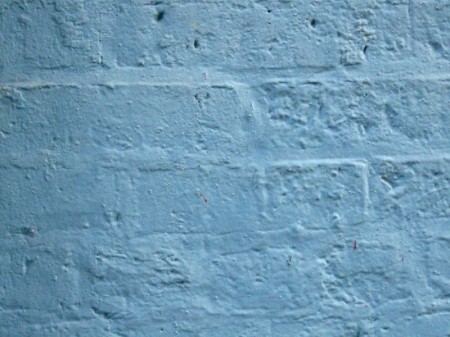







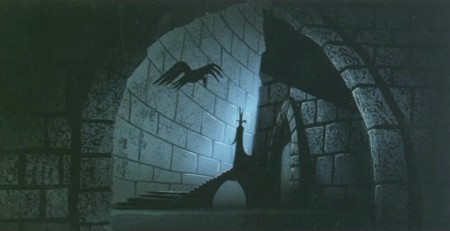
Frame Grabs &Layout & Design &repeated posts 12 Dec 2010 08:06 am
Return to an Eyvind Earle Christmas
- Here’s a piece I posted in December 2007. Since the crèches are popping up all about town, and since I’m such a fan of Eyvind Earle’s work, I love repeating it. The video would make a good Christmas purchase and can be bought here.
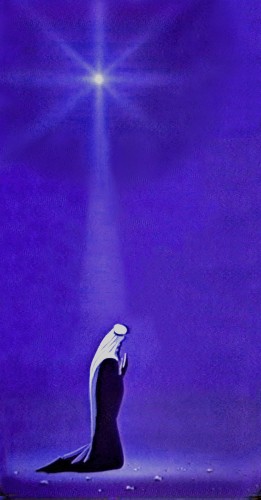 - Here’s a celebration of the animated segments Eyvind Earle did for The Tennessee Ernie Ford Show.
- Here’s a celebration of the animated segments Eyvind Earle did for The Tennessee Ernie Ford Show.
“The Story of Christmas” is a piece which is about ten minutes long set within this half hour special. (Remember when they called them “Specials”?)
The entire show is a Christian sing-along featuring the Roger Wagner Chorale singing around Tennessee Ernie’s gospel read.
The whole is a very reverent piece with no attempt at lightness and comes off as very religious. This would certainly not work on television today, never mind ABC TV which is where it premiered as one episode of the Tennessee Ernie Ford series. Some of you may remember the animated Hubley titles for the show which can be found in John Halas‘ Technique of Film Animation.
Three segments feature the animated graphics with the group singing. The only real narrative tells the birth of Christ in animation. Otherwise the Roger Wagner Chorale, dressed in Dickensian outfits, gather around varied sets looking like the early 19th Century England.
(Click any image to enlarge.)
Earle’s animation was done immediately after Sleeping Beauty was completed. He’d left the studio (or was more probably left by the studio during their massive layoff at the time) and formed his own small independent studio to do work like this. I think this was probably his largest job, and it seems perfectly suited to his style.
Lots of pans and flare effects are built around sliding cells trying to imitate the look of the multiplane camera. There really is no animation here, just the sliding cels of the characters over the pans. It’s still quite attractive for what it is and holds the attention. The piece is well planned and shows off everything Earle had learned at Disney’s studio.
The following are frame grabs from many of the scenes:
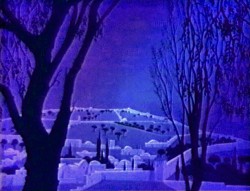 _
_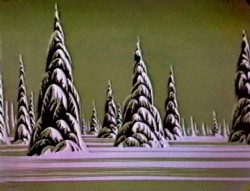
.
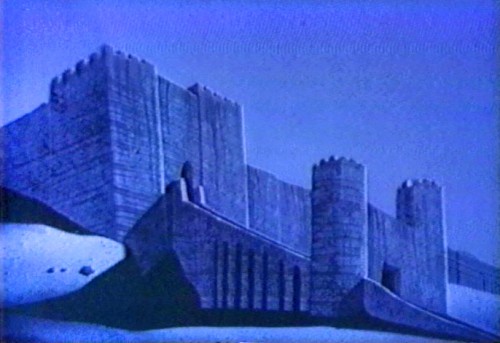
.
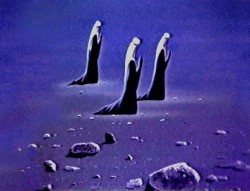 _
_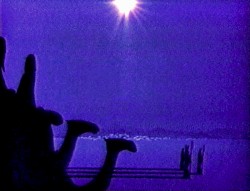
.
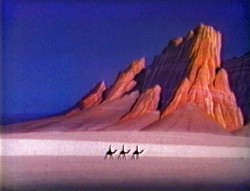 _
_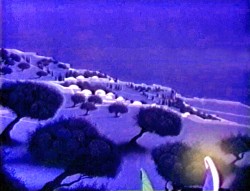
.
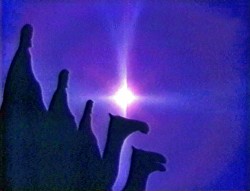 _
_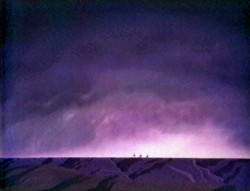
.
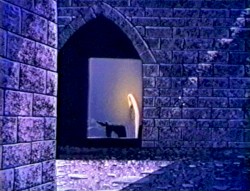 _
_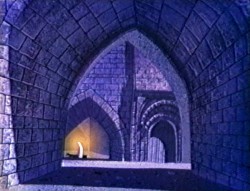
.
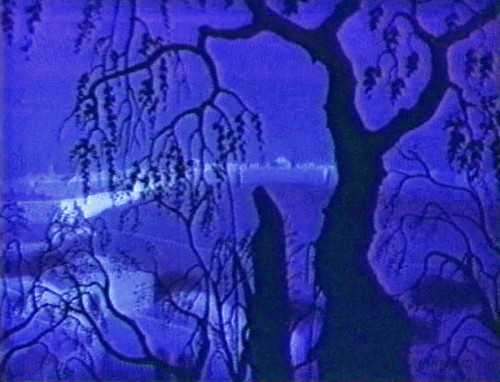
.
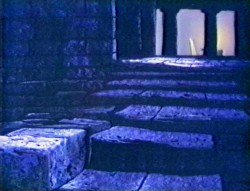 _
_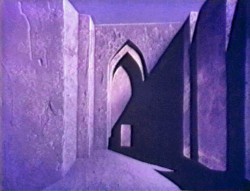
.
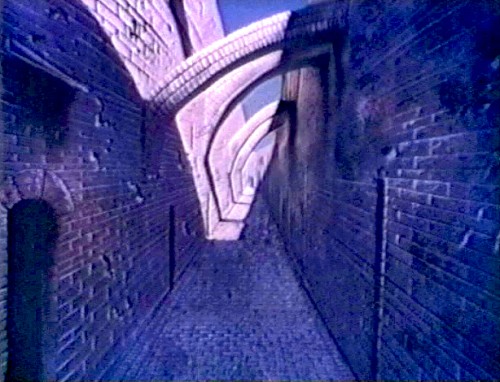
.
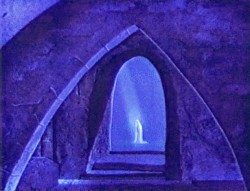 _
_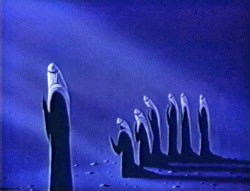
.
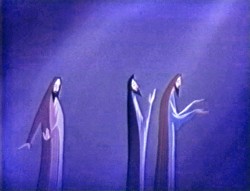 _
_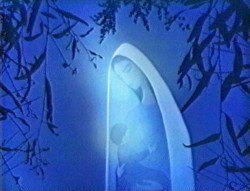
.
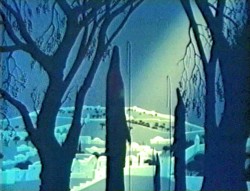 _
_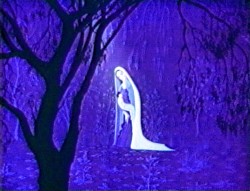
.
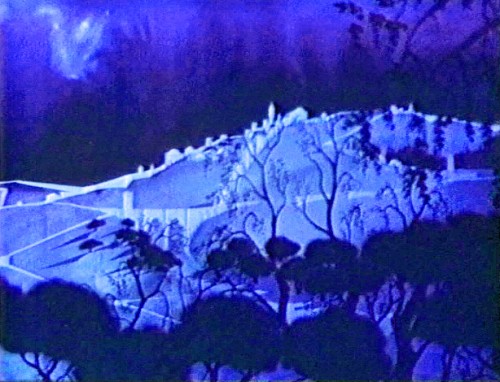
Articles on Animation &Commentary &Daily post &Miyazaki 04 Dec 2010 09:53 am
Grab-bag
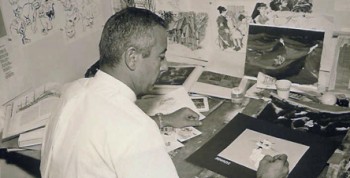 - There’s a wonderful new blog post on Darrell Van Citters’ Mr. Magoo’s Christmas Carol blog. It features the story of Abe Levitow as told by his children, “REMEMBERING THE MOOSE†by Judy, Roberta and Jon Levitow. A great piece to read, I encourage you all to take a look.
- There’s a wonderful new blog post on Darrell Van Citters’ Mr. Magoo’s Christmas Carol blog. It features the story of Abe Levitow as told by his children, “REMEMBERING THE MOOSE†by Judy, Roberta and Jon Levitow. A great piece to read, I encourage you all to take a look.
This is a great site, by the way. Plenty of material about the artists who were involved in those changeover days at UPA. Great artists get their due, lots of artwork from the film and the period, and lots of info to learn.
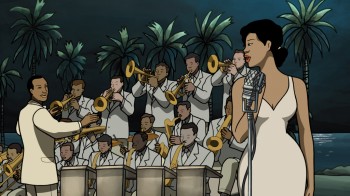 - According to Variety, Disney has picked up the distribution rights for the Spanish animated feature, Chico and Rita. This is director/producer, Fernando Trueba‘s first attempt at directing an animated film. Spanish graphic artist, Javier Mariscal, co-directed the film.
- According to Variety, Disney has picked up the distribution rights for the Spanish animated feature, Chico and Rita. This is director/producer, Fernando Trueba‘s first attempt at directing an animated film. Spanish graphic artist, Javier Mariscal, co-directed the film.
The film celebrates the Cuban jazz pianist, Chico, and his relationship with nightclub singer, Rita, as they leave Cuba to move to the jazz world of the New York in the late 40s.
Disney will release Chico and Rita Feb. 25 on more than 100 screens. (This, of course will allow Disney to enter it into next year’s Oscar fest. in an attempt to get the number up to 16 for a five nominee ballot.)
The film won for best feature at the Holland Animation Film Festival in November. The animated movie continues Trueba’s taste for Latin music, already reflected in three awarded musical docus (“Calle 54,” “Blanco y negro” and “The Miracle of Candeal”) and the creation of a Latin jazz record label.
It’s unlikely they’re expecting a wealth of cash from the distribution of the film except, perhaps, making something from the DVD, if it gets good reviews. I notice that they haven’t picked up the TV rights.
– Meanwhile, writer/director, Geoff Marslett’s animated feature, Mars, opened in New York
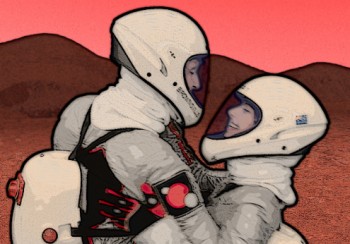 yesterday. The NYTimes review by Jeannette Catsoulis wasn’t all that it might have been. She called it “. . . low key, low budget and low energy . . .” and pretty much left it at that. The film is another of those rotoscoped-animation type things not quite as energetic as “Waking Life†and “A Scanner Darkly.â€
yesterday. The NYTimes review by Jeannette Catsoulis wasn’t all that it might have been. She called it “. . . low key, low budget and low energy . . .” and pretty much left it at that. The film is another of those rotoscoped-animation type things not quite as energetic as “Waking Life†and “A Scanner Darkly.â€
Marslett, who teaches animation at the University of Texas at Austin. The film is playing at: the reRun Gastropub Theater, 147 Front Street, Dumbo, Brooklyn.
- William Benzon, again, has written several excellent pieces on animated films on the blog New Savannah. He has a two part article on Miyazaki‘s film Porko Rosso. The article intelligently argues the idea of a pig, the leading character, being the only non-human in a particular world where no one takes notice. Part 1 and Part 2.
There’s also a third recent article on thoughts generated by Miyazaki in his book, Starting Point, about how he constructs his films with an ever changing and growing storyboard that doesn’t get done until the film is, usually, already being animated. Go here to read this piece.
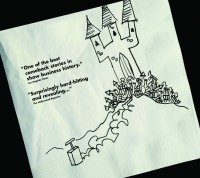 - I received a letter, accompanied by a Press Release, from Don Hahn re the video release of his documentary, Waking Sleeping Beauty. Here’s part of the email letterL
- I received a letter, accompanied by a Press Release, from Don Hahn re the video release of his documentary, Waking Sleeping Beauty. Here’s part of the email letterL
- After a yearlong trek though film festivals and art house cinemas, my documentary WAKING SLEEPING BEAUTY is coming out on DVD this week and I hope you’ll get a chance to review it. WSB tracks the renaissance of Disney Animation from box office disappointments and the near closure of the studio, to great success with films like The Little Mermaid, Beauty and the Beast and The Lion King.
The positive response to the film has been bigger than I ever imagined. Not only has it appealed to the fans of animation, it’s also struck a chord with corporations and organizations of all kinds that have gone through their own periods of declines and resurrections. We found that WAKING SLEEPING BEAUTY not only entertained, but touched people emotionally as well.
The DVD has over 80 minutes of bonus material with amazing footage of Howard Ashman working with Jodi Benson during the recording sessions for The Little Mermaid and Howard’s priceless talk to the animation crew about musical theater and animation. I also put together an audio commentary track that features alternate narration from Peter Schneider and myself as well as new unheard material from Glen Keane, Mike Gabriel, Kirk Wise, Rob Minkoff, Jeffrey Katzenberg and Roy Disney.
I hope you’ll get a chance to view the doc and announce to your readers that WAKING SLEEPING BEAUTY is out on DVD tomorrow, November 30th.
I wrote about this film and reviewed it when it was released theatrically back in March of this year. You can read that here.
Animation &Commentary &Disney 30 Nov 2010 08:26 am
Keane Posing
- Before posting this, let me tell you that I have all the respect in the world for Glen Keane. He’s one of the finest animators out there who consistently does original animation.
 Last night I saw Tangled at a screening in 2D. I would have liked to have seen it in 3D, though EVERY review I’ve seen has put down the 3D experience saying that the glasses darken the movie to less than 60% of the brilliance on film. I doubt I’ll see it again for the 3D; if I do see it again it’ll be on DVD.
Last night I saw Tangled at a screening in 2D. I would have liked to have seen it in 3D, though EVERY review I’ve seen has put down the 3D experience saying that the glasses darken the movie to less than 60% of the brilliance on film. I doubt I’ll see it again for the 3D; if I do see it again it’ll be on DVD.
The history of the Disney studio. The film, itself, is basically a reworking of Beauty and the Beast (the magic flower, the bad male who has to be transformed into a good guy), Snow White (the wicked queen and the magic mirrors – two of them have to be broken), Cinderella (she cleans the tower for her wicked stepmother – or is this more of Snow White?), Sleeping Beauty (the horse with his own mind, the Princess awakens the sleeping Prince – or is this Snow White again?), The Little Mermaid (She looks like Ariel, the Little Mermaid with the hair that she just has to keep pushing back), Tarzan (the two lead characters skateboard over water and some paving, yet they don’t have skateboards). I could go on through some other films, but what’s the point?
Several of these female characters showed their spunk and advanced their Independence. In Tangled, Rapunzel goes after what she wants but doesn’t create her own fate, in the end. The male does. One expected it would be the wicked stepmother, but no, it’s the Prince … er Robber/Thief/Scoundrel. Inadequate. This is a film for 14 year old girls, and we see that they’ve seen it this past weekend, but they’re given the wrong version of the story.
The story in Tangled is smooth flowing, but crudely formed. It’s a mass of unbelievable material that rips apart one of the darker and great stories from the Brothers Grimm first published in 1812. The story is a nasty one which begins with a king, personally, stealing a plant from the witch’s garden to help his wife. She catches him on the spot and makes him promise his first born in payment.The king is RESPONSIBLE for his theft. Rapunzel moves to the tower and is protected from sex with her caging in the tower.
The film doesn’t use the hair very well. It is the sex that isn’t otherwise stated, and some symbolism should have entered the animation; it didn’t have to be obvious – it just had to be there. The incidental characters – all male seem to have bonded well, but we have no idea who they are or what their sexual preferences are. Again, the film seems unwilling to deal with the main subject of this great fairy tale. A stepmother trying to protect her daughter from the evils of the world. (Men!) Instead, this film is about ripping off Disney past. Yet we did see in Jeff Kurti‘s book on The Art of . . . that Rembrant was a major source of inspiration in the earlier days. Too bad too little of Rembrandt made it to the screen.
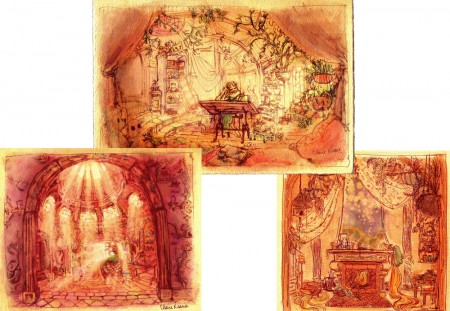
Just prior to going to this screening, I watched the first half of Tarzan on tv. Below, I’m going to post a number of drawings showing some clichéd poses by Glen Keane, but these poses don’t represent the animation he does on screen. He’s too good and sensitive an animator to show any clichés in the actual animation on screen. In fact, some of what he does is quite inspired. (Not the idea of Tarzan skateboarding through the trees without a skateboard. I expect the soles of his feet would be bloodied and damaged after trying it once, and I don’t think there’s scar tissue for it. It’s a small reality issue for me.) It’s just that these model sheet poses inspire clichés from lesser animators when they’re the poses.
Tangled is totally watchable (despite a couple of children running around the screening room, bored and loud). It’s just not good; story is everything.
Here are a bunch of drawings I culled from Raul Andres‘ blog, The Art of Glen Keane. I have to admit my purpose isn’t to showcase the art of Mr. Keane, but to express my disappointment with what I’ve found. It first became obvious to me with many of the drawings and models of his that were printed in the book, The Art of Tangled. Many of the poses he’s done since Beauty and the Beast have gone to the clichéd pose, and it’s disconcerting to me. Characters look like each other, and their facial postitions repeat the past. It’s a laziness in the drawing.
Look and compare drawings with this small sample. It took only minutes for me to compile them, and I could easily have kept going.
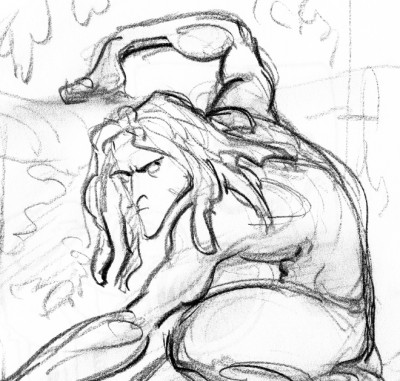
Tarzan 1
The problem, to me, is that Glen Keane has grown into this phase of reworking the same godawful poses. He has to come to grips with what he’s doing, and pay more attention it. There’s no excuse. It isn’t so obvious in his animation, just in his model sheets.
You wouldn’t be able to catch two poses from Frank Thomas, Milt Kahl or Ward Kimball that were so alike. There were no obvious clichés in their work.
Glen Keane is a remarkable artist and a brilliant animator. That is exactly why I have to take notice. There are many others aping what he’s doing in animation, and the kingdom is beset with endless clichéd poses. Let’s get it together, folks. Time to bring animation to a higher level.
Attitude has got to be a thing of the past. It’s rampant in Tangled, Toy Story 3 and to a lesser degree in Kung Fu Panda; it’s not obvious in How To Train Your Dragon. The independent films, The Illusionist and My Dog Tulip don’t settle into this type of posing. Strong, clear thinking artists dominate these two films.
Animation &Animation Artifacts &Disney 04 Aug 2010 06:21 am
P&W-Kimball Scene – 8
- Production #2024, MAKE MINE MUSIC, “Peter and the Wolf”. Sequence 7, Scene 96. Animator: Ward Kimball.
Completing the post of the little guy on the separate level, here are the final drawings of the scene. There are other levels of snow animation and footprint animation, but I won’t post those. This scene was large enough.
As usual, we start with the last drawing from last week’s post.
Enjoy.
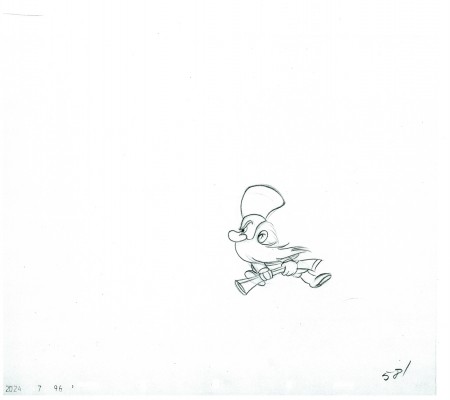 581
581
The following QT movie represents all the drawings of the bottom level
as well as the drawings of the Little Guy, on another level,
who comes in and out where he should.
I exposed all drawings on ones.
Right side to watch single frame.
To see the past five parts of the scene go to:
Part 1, Part 2, Part 3, Part 4, Part 5, Part 6, and Part 7.
My thoughts on this scene – just my opinion
I’m pretty disappointed in what I’ve seen here. The work has the obvious flair and panache of a typical Ward Kimball scene. The movement is funny and creative. Kimball did his work. The assistants were out to lunch.
The drawing in the scene is not the top notch material I’d expect of a Disney team. Seeing it drawing by drawing I get to see what I don’t like from a lot of the work in this period. The drawing just changes and doesn’t live up to the originals. Just looking at the fingers you get to see them turn into, what we in NY call, “Banana fingers” – they flatten out. This is part and parcel of the work at Terrytoons or Paramount, but we’re talking Disney here. You wouldn’t catch that in Sleeping Beauty or Bambi or Dumbo or Snow White or 101 Dalmatians. But it’s there in these compilation features.
Now going through the many drawings I’ve posted by Bill Tytla, I notice a distinct tie to Terrytoons. In the dwarves and especially in Stromboli a soft roundness comes into his drawings (and the assistant keeps it) at times. It’s probably the influence of Connie Rasinski while Tytla was there. It isn’t a bad thing, it’s certainly part of the style Tytla brought to his work. He took something good from Terry (the bottom) and brought it to Disney (the top), and he made it work into something glorious. If anyone was an artist in animation, it was Bill Tytla. But that isn’t what I’m talking about with the work in this Kimball scene.
All right the schedule was probably ridiculously tight – it was – and the budget was probably underbudgeted – it was. But I remember Jack Schnerk (who assisted at Disney) telling me about the last six months of work on Bambi when work went into overdrive. Everyone was forced to work seven days a week and most slept on their desks to get it done. The work was so heavy he quit after the film was finished. But then that was pre-IATSE and the compilation features were not. That was also when Walt was intimately involved in the films and he was not so involved in the compilation films.
Something different: for some reason WordPress will not let me save the word “‘O’nion” (replace a “U” for the “O” and you’ll have the word I mean.) If I try to save a piece with that word in it, it erases the material. I’ve used IATSE in its place for this piece. This has gone on for the last year. Anyone with a suggestion?
